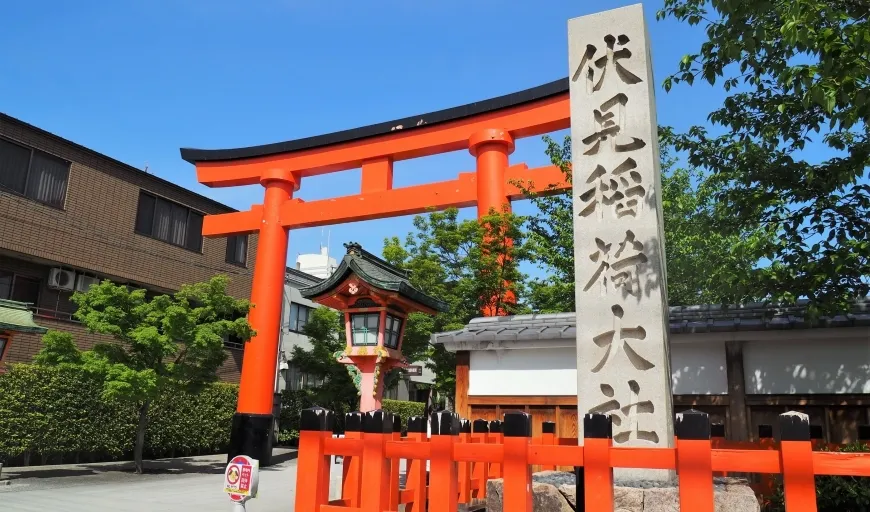Fushimi Inari Taisha is a famous shrine in Kyoto, known for its thousands of bright red torii gates.
These gates form magical paths through the forest, creating one of Japan’s most iconic and photogenic spots. Visitors from around the world come year-round to experience its beauty and spiritual atmosphere.
The shrine honors the gods of business success and good harvests, and has a long history surrounded by nature.
In this guide, you’ll find everything you need to visit: the shrine’s background, blessings, highlights, opening hours, access, parking, and tips on goshuin (stamp books) and omamori (charms). Enjoy your visit to this unforgettable place.
- History & Origins of Fushimi Inari Taisha
- Deities Enshrined at Fushimi Inari Taisha
- Blessings of Fushimi Inari Taisha
- Visitor Stories: Wishes Fulfilled at Fushimi Inari
- Highlights of Fushimi Inari Taisha
- Suggested Visit Duration & Routes
- Goshuin (Shrine Stamps) at Fushimi Inari Taisha
- Amulets at Fushimi Inari Taisha
- Basic Information
- Parking at Fushimi Inari Taisha
- How to Get to Fushimi Inari Taisha
- Summary
History & Origins of Fushimi Inari Taisha
Fushimi Inari Taisha was founded in 711, making it one of Japan’s oldest shrines with over 1,300 years of history. It began when Hata no Iroku, a member of the Hata clan known for silk and weaving, enshrined the deity Inari on five peaks of Mount Inari.
During the Heian period
Inari became a guardian of the capital and was honored by the imperial court. Over time, the deity gained the highest rank in the Shinto hierarchy and was worshipped for blessings like good harvests, business success, and family safety.
In the Kamakura and Muromachi periods
Samurai such as Minamoto no Yoritomo prayed to Inari for victory in battle. The shrine expanded, and new worship halls were built at the base of the mountain, making it easier for people to visit. The layout of upper, middle, and lower shrines was formed during this time.
In the Edo period
Inari worship spread nationwide. Groups called “Inari-ko” organized pilgrimages and built local shrines. People began donating torii gates to show gratitude for fulfilled wishes, this tradition led to the famous Senbon Torii (Thousand Torii Gates).
In the Meiji era
The shrine became officially recognized by the government. After the separation of Shinto and Buddhism, Fushimi Inari Taisha focused solely on Shinto practices. Even as Japan modernized, worshippers continued to visit for blessings in business, health, and happiness.
Today, the shrine operates independently and remains deeply loved. Its iconic red gates have appeared in movies and anime, attracting younger visitors and tourists from around the world. Fushimi Inari Taisha is now one of Japan’s most visited and photographed spiritual sites.
Deities Enshrined at Fushimi Inari Taisha
Fushimi Inari Taisha honors five main deities, collectively known as Inari Ōkami. Each has unique blessings and roles in Japanese mythology and daily life.
Ukanomitama no Okami
The central deity of Inari shrines, worshipped as the goddess of rice, agriculture, and prosperity. She is affectionately known as “O-Inari-san.”
Blessings: Good harvests, business success, family safety, and overall fortune.
Sadahiko no Okami
Linked to Sarutahiko Ōkami, a guide deity who leads people on the right path.
Blessings: Safe travel, good luck, protection from misfortune, and matchmaking.
Omiyanome no Okami
A graceful goddess associated with harmony and palace peace.
Blessings: Artistic talent, happy relationships, prosperity, and household safety.
Tanaka no Okami
A local agricultural deity, deeply connected to rice fields and farming life.
Blessings: Abundant crops, thriving livelihoods, and land protection.
Shino Okami
A composite deity representing several gods once worshipped at sacred spots on Mount Inari.
Blessings: Business success, wish fulfillment, good fortune, and family well-being.
Blessings of Fushimi Inari Taisha
Fushimi Inari Taisha has long been cherished as a shrine that supports everyday life. Visitors come to pray for various blessings, including:
Business Success
Inari Okami is widely worshipped as a god of prosperity. Many shops and companies visit to pray for thriving business.
Good Harvests
As a deity of rice and agriculture, Inari is deeply respected by farmers and food-related industries.
Family Safety
People pray for the health and safety of their loved ones and peaceful home life.
Good Fortune
Visitors seek blessings to overcome challenges and invite happiness into their lives.
Safe Travel
Sadahiko Okami, a guiding deity, is believed to protect travelers and commuters.
Artistic Growth
Omiyanome Okami is linked to the performing arts, attracting those who wish to improve in music, dance, or theater.
Love & Relationships
As a goddess of harmony, Omiyanome Okami also brings blessings for romantic connections and happy marriages.
Visitor Stories: Wishes Fulfilled at Fushimi Inari
Many people believe that praying at Fushimi Inari Taisha can help with business success, financial luck, love, and more. Here are a few personal stories:
- I run a small business. After praying for prosperity and walking through the Senbon Torii daily, my sales nearly doubled within six months.(Male, 30s)
- I was struggling with job hunting and prayed seriously at several sacred spots. A few weeks later, I got an offer from my dream company.(Female, 20s)
- After losing money in stocks, I visited the shrine and lifted the Omokaru Stone. It felt lighter the second time. Slowly, I recovered my losses.(Male, 40s)
- I prayed to reconnect with my ex. After many visits and walking through the torii gates with care, he reached out—and we got back together.(Female, 30s)
- I was anxious about finding a job. After praying for guidance, I was unexpectedly introduced to a company and received an offer.(Male, 20s)
- These are personal experiences and results may vary, but many visitors feel spiritually uplifted and supported after visiting Fushimi Inari Taisha.
Highlights of Fushimi Inari Taisha
Fushimi Inari Taisha spans from the grand entrance gate to the sacred summit of Mount Inari (233m), offering many unique spots to explore.
Romon Gate
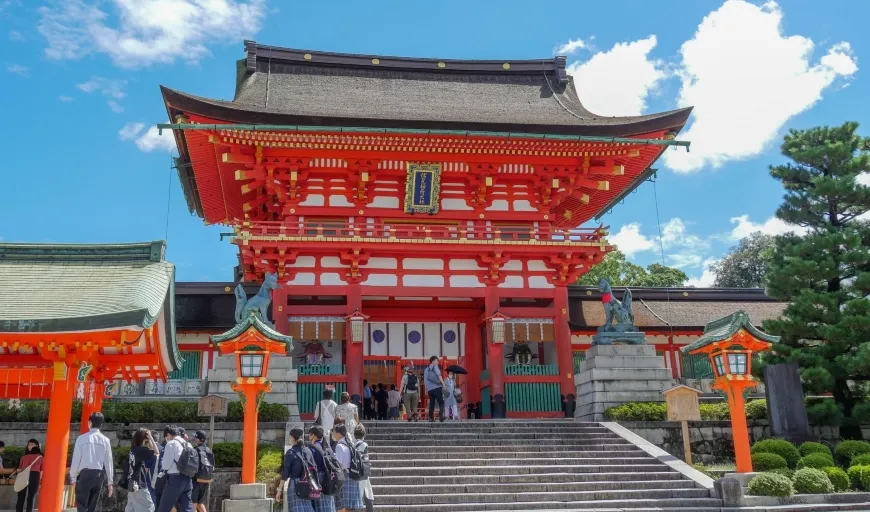
Built in 1589 by Toyotomi Hideyoshi to pray for his mothers recovery. It’s one of the largest shrine gates in Japan and a designated Important Cultural Property.
Main Hall (Honden)
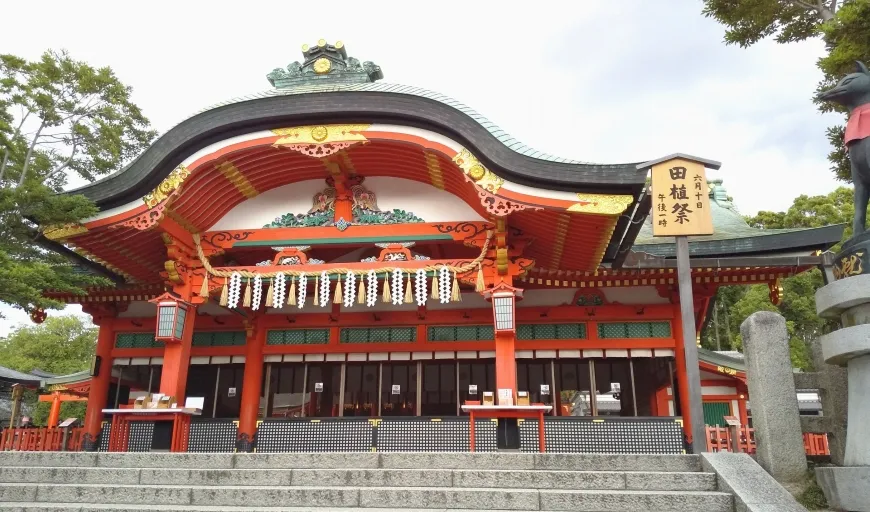
Rebuilt in 1499 after the Onin War, this hall enshrines five deities known as Inari Okami. It features classic Muromachi-era architecture and is also an Important Cultural Property.
Fox Statues
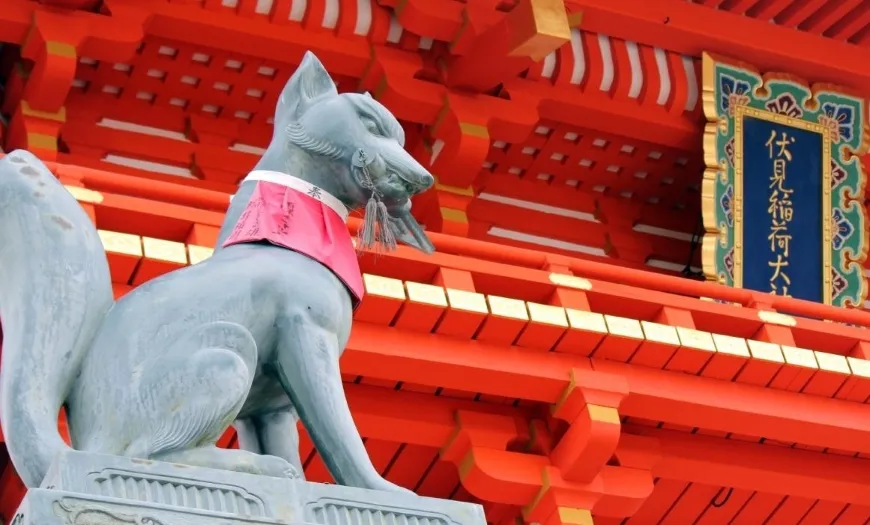
伏見稲荷大社に点在する白狐
Foxes are messengers of Inari. White fox statues are especially sacred, often holding items like rice stalks (harvest), keys (safety), jewels (spiritual power), or scrolls (wisdom).
Senbon Torii (Thousand Torii Gates)
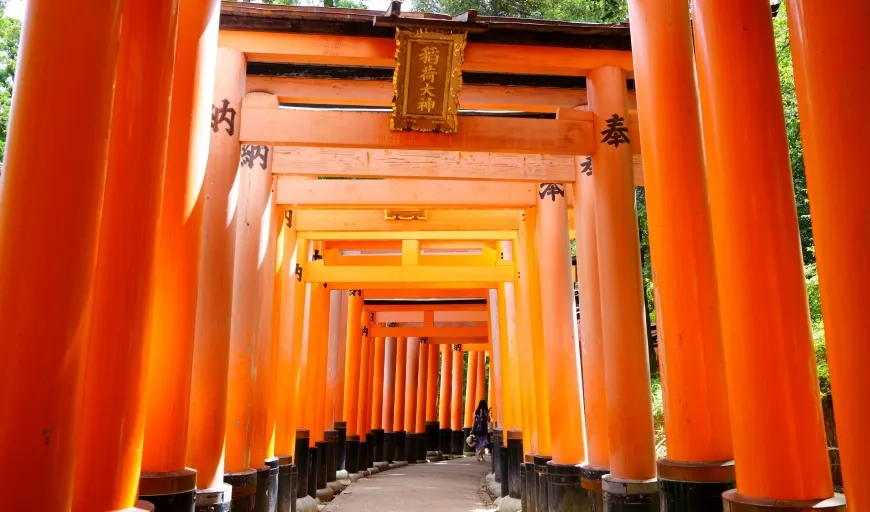
A famous tunnel of red gates leading to the inner shrine. Donated by individuals and businesses to express gratitude for fulfilled wishes. Best visited early morning or late afternoon to avoid crowds.
Omokaru Stone
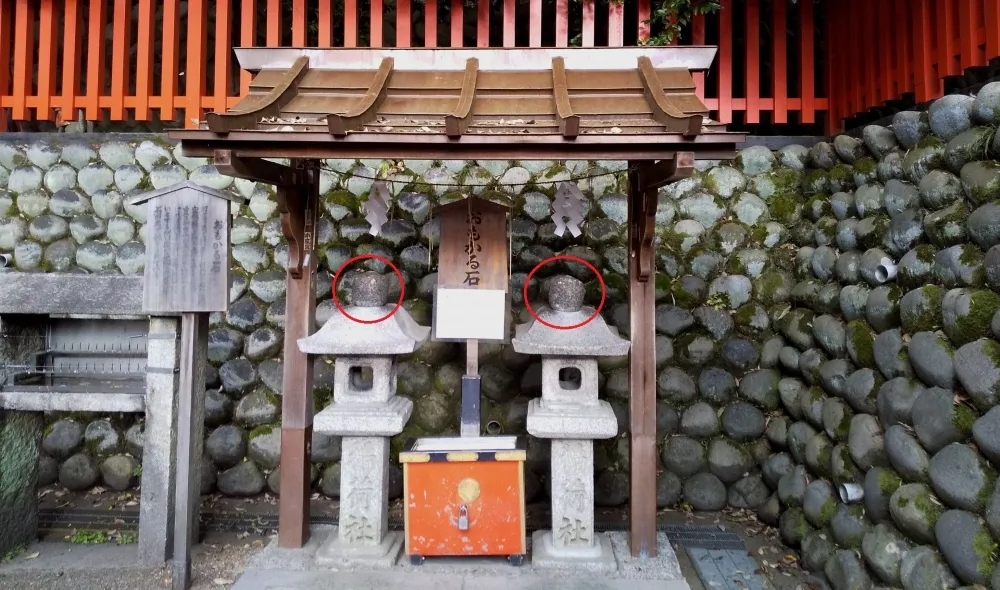
Located near the inner shrine. Lift the stone while making a wish, if it feels light, your wish may come true!
Root-Rising Pine

伏見稲荷大社 根上がりの松
A pine tree with raised roots, believed to bring financial luck and healing for knee or back pain.
Mount Inari
A sacred mountain with multiple peaks and over 10,000 torii gates. Pilgrims hike the trail to visit holy spots and small shrines along the way.
Cats of Inari
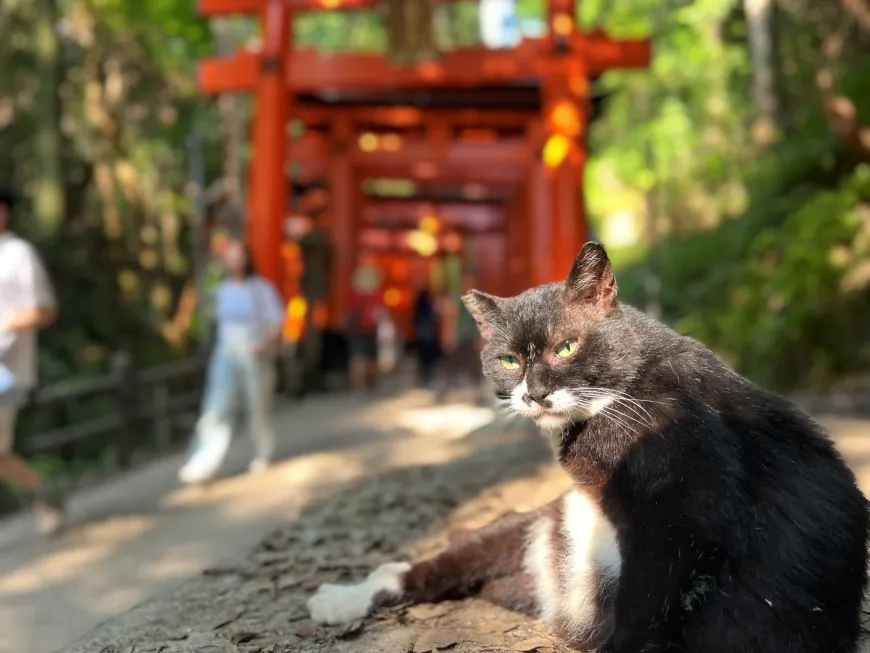
Fushimi Inari is also known for friendly cats lounging near the torii paths, adding charm to your visit.
Inner Shrine (Oku-no-sha)
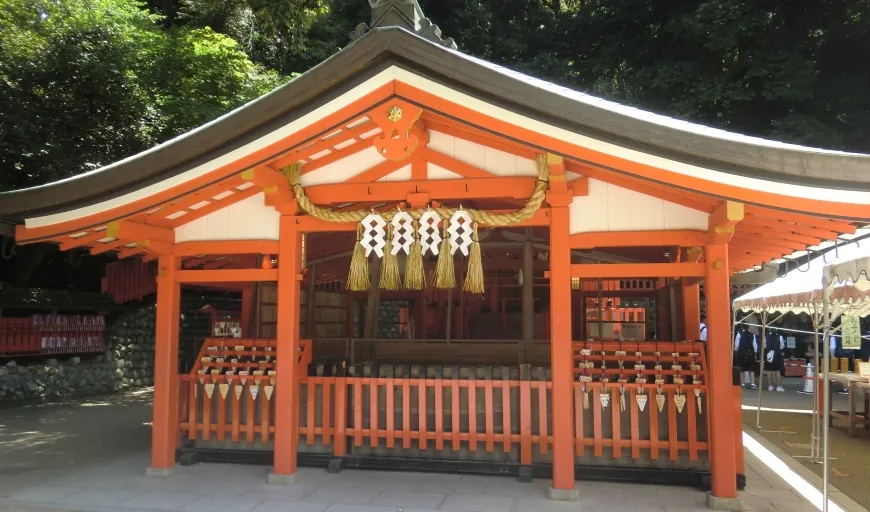
A key worship site facing the three sacred peaks. It’s the spiritual heart of the mountain trail.
Kumataka Shrine
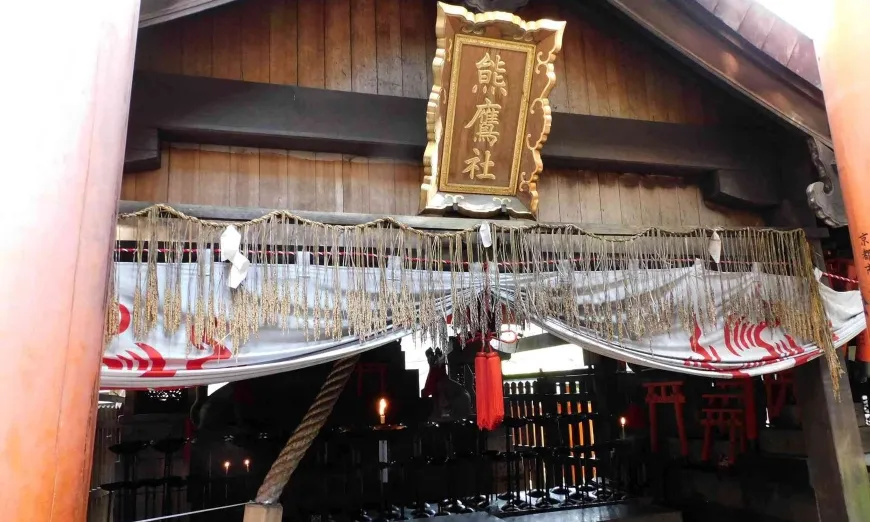
Dedicated to the powerful Kumataka deity. Visitors pray for success, focus, business prosperity, and eye health.
Kojin Peak
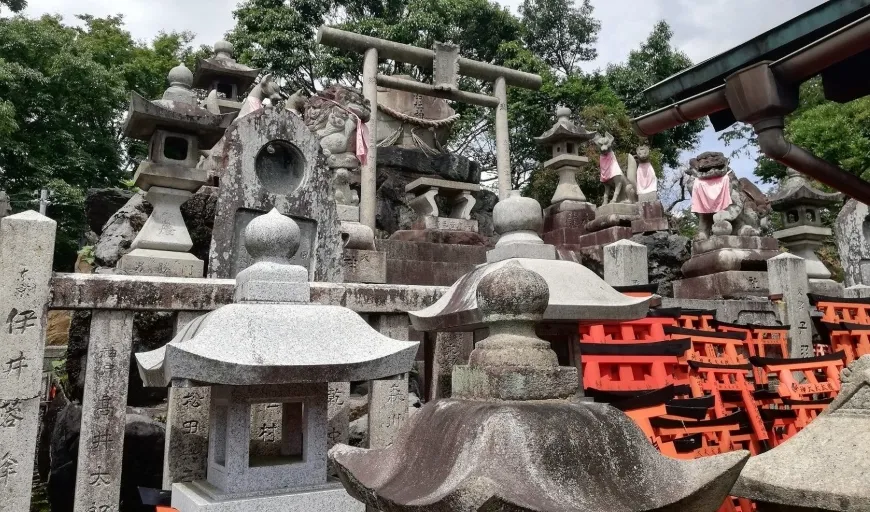
Home to the fire deity Kojin. Worshipped for protection from fire, misfortune, and to ensure family safety.
Mitsurugi Shrine
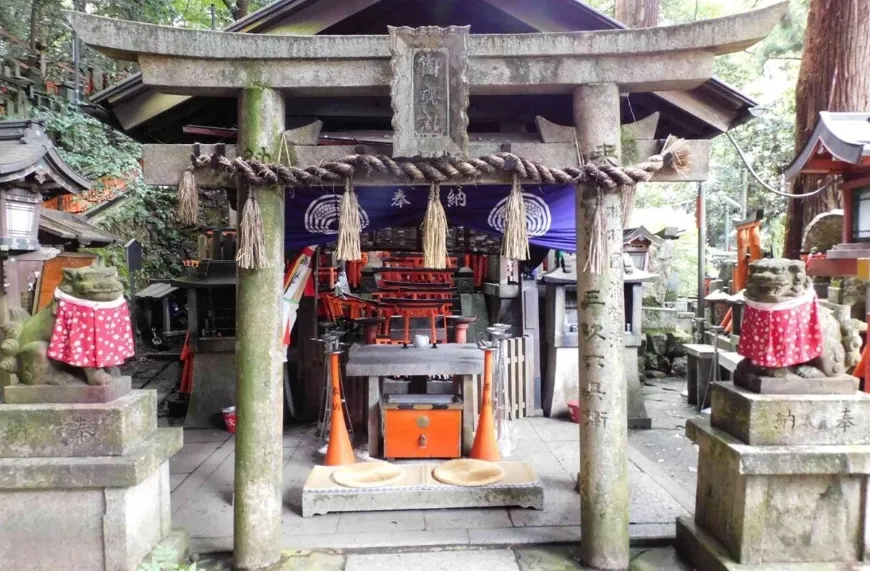
Also called Choja Shrine, it enshrines Susanoo-no-Mikoto, a heroic god known for defeating evil. Offers blessings for health, protection, and victory.
Ichinomine (First Peak)
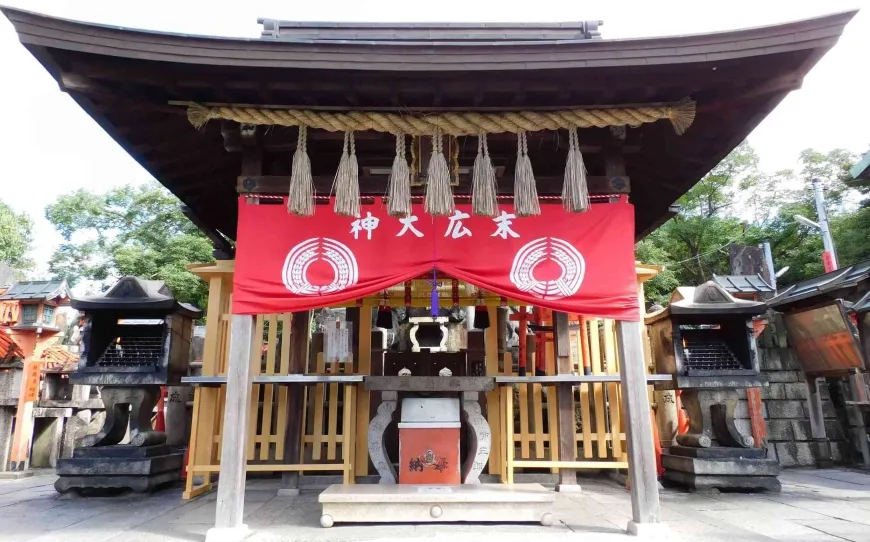
The highest point of Mount Inari. Worshipped for wish fulfillment, good fortune, and business success.
Ninomine (Second Peak)
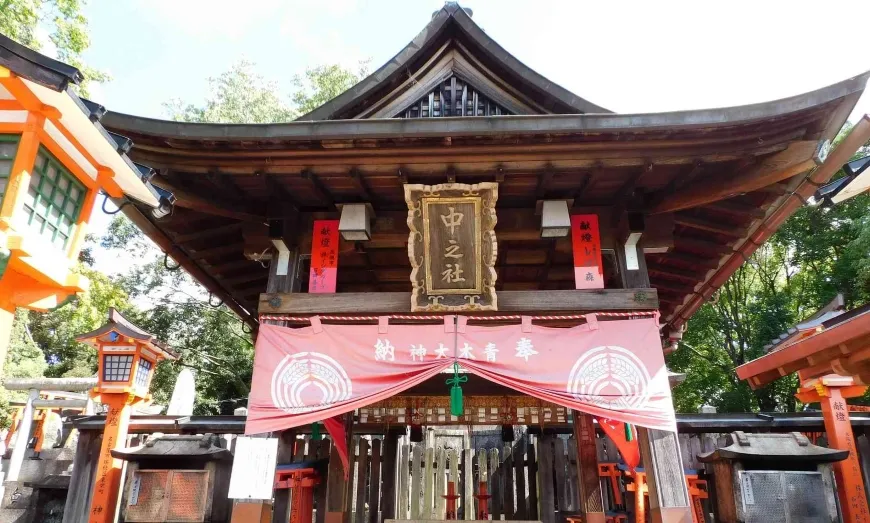
Enshrines Sadahiko and Tanaka deities. Known for blessings in travel safety, prosperity, and agriculture.
Ainomine (Middle Peak)
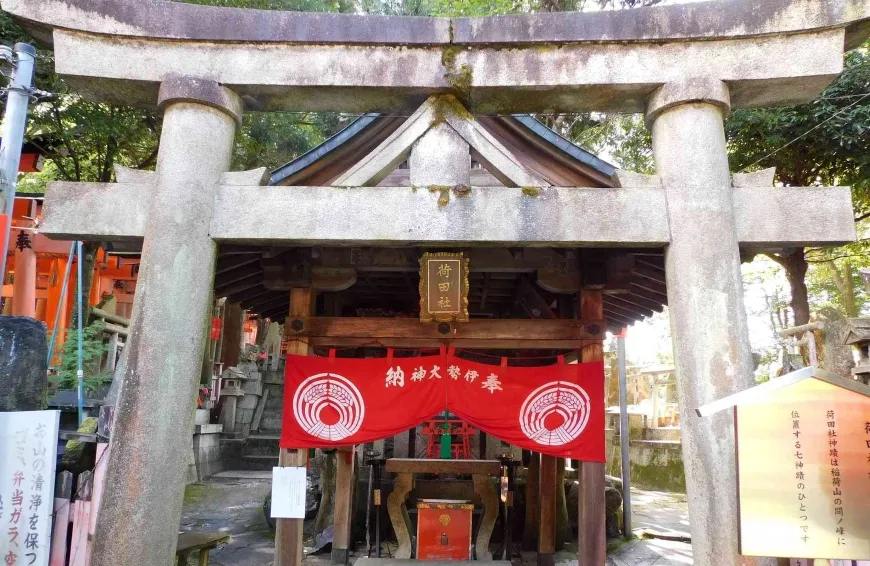
Located between the second and third peaks. Worshipped for business success, financial luck, and family safety.
Sannomine (Third Peak)
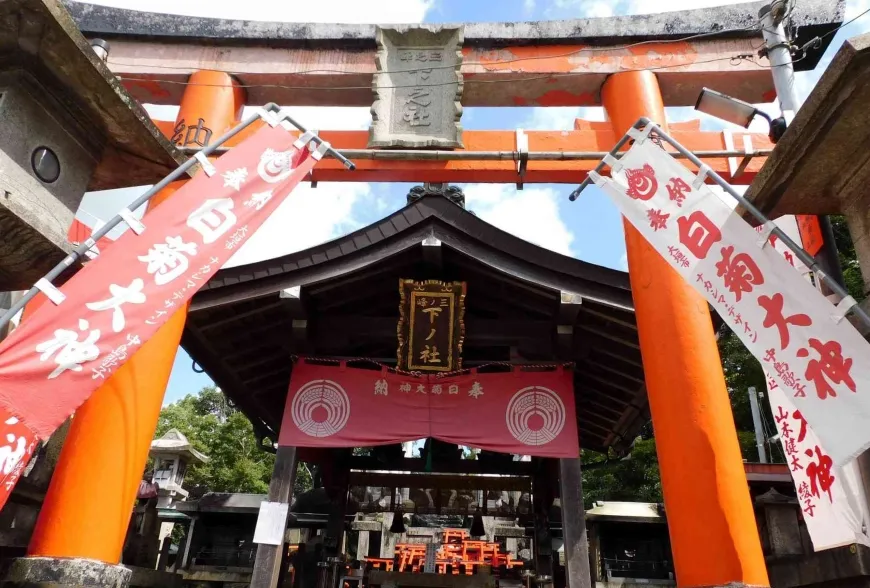
Closest to the base. Enshrines Shiragiku deity, associated with wealth and prosperity.
Suggested Visit Duration & Routes
Fushimi Inari Taisha covers a vast sacred area, including Mount Inari. Depending on your time and energy, you can choose from several walking routes:
Beginner Route: Senbon Torii & Inner Shrine
Duration: 30–40 minutes round trip
Route: From the main hall through the famous red torii gates to the inner shrine (Oku-no-sha)
Highlights: Senbon Torii, Omokaru Stone (wish test)
Best for: Short visits or low-energy days
Intermediate Route: Yotsutsuji Viewpoint
Duration: 50–70 minutes round trip
Route: Continue uphill past the inner shrine to Yotsutsuji
Highlights: Panoramic city views, Root-Rising Pine, Kumataka Shrine
Best for: Scenic walks with moderate effort
Advanced Route: Summit of Mount Inari (Ichinomine)
Duration: 90–120 minutes round trip
Route: Full mountain hike from base to summit
Highlights: Sacred peak, full shrine trail experience
Best for: Energetic visitors seeking spiritual depth
You can also enjoy a Quick Visit Route (about 30 minutes) covering the main hall, Senbon Torii, and inner shrine.
Goshuin (Shrine Stamps) at Fushimi Inari Taisha
Visitors can receive goshuin (sacred stamps) at the shrine office. If you don’t have a stamp book, original goshuin books are available for purchase.
Types of Goshuin
There are three main goshuin, each available for a ¥500 offering:
Main Hall Goshuin
The most common stamp, featuring the shrine name, visit date, and red seal with rice and fox motifs.
Inner Shrine Goshuin (Oku-no-sha)
Located beyond the Senbon Torii. This stamp has a different design from the main hall.
Gozen-dani Goshuin
Found halfway up Mount Inari. It uses the word “登拝” (mountain worship), reflecting the effort to reach it.
Limited Edition Goshuin
Special stamps are offered during seasonal festivals or events. These feature unique designs and colors. Offering: ¥500–¥1,000.
Nearby Shrine: Higashimaru Jinja
You can also receive a goshuin from Higashimaru Shrine, next to Fushimi Inari. Dedicated to the god of learning, it often features plum blossom motifs. Offering: ¥300.
Amulets at Fushimi Inari Taisha
Fushimi Inari Taisha offers a wide variety of amulets, each designed to support specific wishes. You can receive them at the main hall or inner shrine.
Popular Amulet Types
Senbon Torii Amulet
Inspired by the shrine’s iconic red gates. A popular keepsake.
Fox Amulet (Strap Type)
Features foxes, messengers of Inari. Available in various colors and expressions.
Business Prosperity Amulet
Prayers for success in work and commerce.
Good Fortune Amulet
Helps attract luck and protect against misfortune.
Family Safety Amulet
For health and peace within the home.
Traffic Safety Amulet
For safe travel. Some feature fox or car designs.
Academic Success Amulet
Linked to nearby Higashimaru Shrine, dedicated to learning and exams.
Health & Longevity Amulet
For daily wellness and protection from illness.
Love & Relationship Amulet
For romantic connections and happy partnerships.
Basic Information
Address: 68 Fukakusa Yabunouchi-cho, Fushimi-ku, Kyoto 612-0882, Japan
Phone: +81-75-641-7331 Fax: +81-75-642-2153
Admission: Free of charge
Main Deities:
-Ukanomitama no Ōkami
-Sadahiko no Ōkami
-Omiyanome no Ōkami
-Tanaka no Ōkami
-Shino Ōkami
Blessings Offered:
-Business prosperity
-Good harvests
-Family safety
-Good fortune
-Traffic safety
-Artistic growth
-Love and relationships
Official Website: https://inari.jp/en/
Parking at Fushimi Inari Taisha
Fushimi Inari Taisha offers a visitor-only parking lot, along with several paid parking options nearby.
Shrine Parking Lot (Official)
-Location: Right side of the main entrance torii gate
-Hours: 8:00 AM – 6:00 PM (no entry/exit outside hours)
-Fee: First hour free, then ¥200 per 30 minutes
-Capacity: Approx. 170 cars
-Closed annually from Dec 29 to Jan 6
-Note: Very crowded on weekends and holidays
If full, please use nearby paid parking lots.
Nearby Paid Parking Options
Here are three coin-operated lots close to the shrine:
1. Park Station 24 Fushimi Inari
-8:00–20:00 (Weekdays): ¥200/40 min
-8:00–20:00 (Weekends/1st of month): ¥200/10 min
-20:00–8:00: ¥200/60 min
-Max: ¥1,200 (day), ¥500 (night)
-Capacity: 11 cars
-Open 24 hours
2. Boo Boo Park Fukakusa Notemachi
-8:00–20:00: ¥200/40 min (Max ¥500)
-20:00–8:00: ¥100/60 min (Max ¥300)
-Capacity: 6 cars
-Open 24 hours
3. NPC24H Fushimi Inari Taisha-mae
-Daytime: ¥200/15 min
-Night: ¥200/30 min
-Max: ¥1,000 (weekday), ¥2,000 (weekend), ¥400 (night)
-Capacity: 12 cars
-Open 24 hours
Tip: Parking may be full during peak hours. Public transportation is often more convenient.
How to Get to Fushimi Inari Taisha
Fushimi Inari Taisha is easily accessible by train, bus, car, or taxi.
From Kyoto Station
– JR Nara Line: Take a train toward Nara and get off at Inari Station (5 min, ¥150 one-way).
– City Bus (Minami 5): Ride to Inari Taisha-mae (20–30 min, ¥230 one-way).
By Train
– JR Nara Line: Get off at Inari Station — right in front of the shrine (most convenient).
– Keihan Main Line: Get off at Fushimi Inari Station — about 5 minutes on foot through a shopping street.
By Bus
– Kyoto City Bus (Route Minami 5): Get off at Inari Taisha-mae, then walk about 7 minutes.
Buses run from Kyoto Station, Shijo Kawaramachi, and other major areas.
By Car
– From Meishin Expressway Kyoto Minami IC: approx. 20 minutes
– From Hanshin Expressway Kamitoba Exit: approx. 10 minutes
By Taxi
– From Kyoto Station: approx. 15–20 minutes
– Fare: around ¥1,500–¥2,000 (may vary by traffic)
Summary
Fushimi Inari Taisha is one of Japan’s oldest and most revered shrines, with a history dating back to the Nara period. Known for its blessings in business prosperity and beyond, the shrine continues to inspire visitors with its spiritual power.
From the iconic Senbon Torii—thousands of vivid red gates forming a mystical path—to the majestic main hall and the sacred, nature-rich Mount Inari, the site offers countless highlights.
This article has covered everything you need to know for your visit: the shrine’s history, blessings, must-see spots, and access information. We hope it helps make your experience at Fushimi Inari Taisha deeper and more meaningful.
We warmly invite you to step into this sacred space and feel its divine atmosphere for yourself.
For details about Higashi Fushimi Inari Shrine—an important shrine in eastern Japan that received a direct spiritual transfer from Fushimi Inari Taisha—please see the article below.

